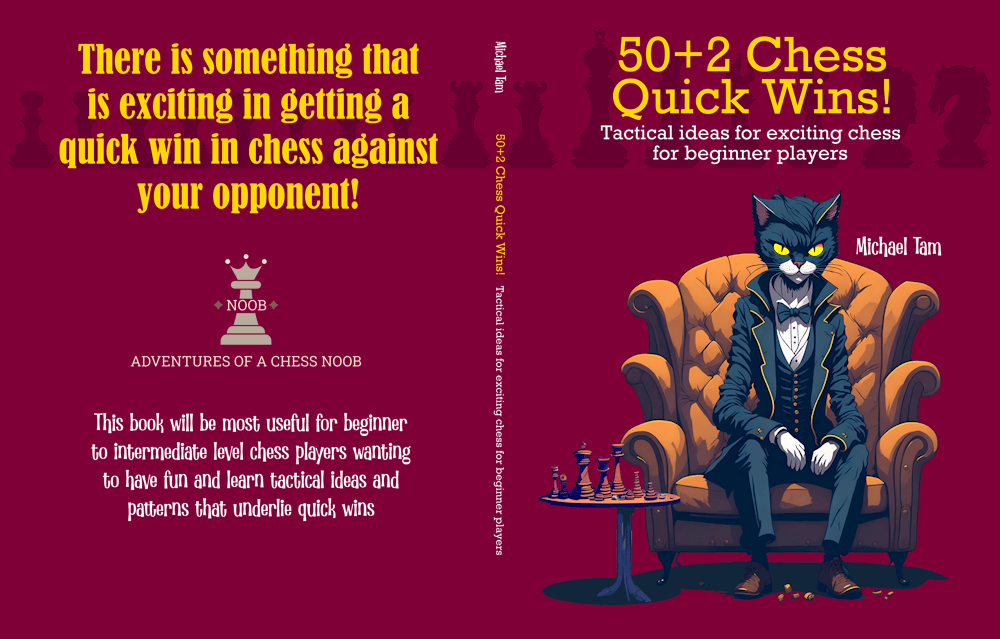
OTB Chess | EPIC WINNING with the Romantic Style! 🤩👍
#otb #romanticstyle #french #english #englund
Last week I attended an academic conference in Perth. For those who aren’t familiar with Australia, Perth is the capital city of the state of Western Australia and is on the west coast of the Australian continent. Effectively, it is the opposite side of the country from Sydney: it is five hours by plane and three time zones away!

![]()
Mrs Chess Noob also attended the conference and Little Chess Noob came along as well! We visited Penguin Island which is about an hour south of Perth to see the wildlife. Little Chess Noob is especially keen on lizards and the King’s skink is one of the largest skinks in the world. The King’s skink is especially common on Rottnest Island and Penguin Island in Western Australia.

![]()
Perhaps, contrary to the stereotype of Australian animals, neither the skink nor tern are dangerous creatures. In fact, Penguin Island as a nature reserve doesn’t have any animals that would try to kill a human! 😌
That isn’t to say that it’s entire safe on the beaches of the Western Australian coast. The Western Brown Snake is commonly found on the beach, and though less aggressive than the Eastern Brown, it has nonetheless a potent neurotoxic venom which should always be assumed to be life-threatening if bitten. 🐍😬

![]()
I always bring along a portable chess set when I go to conferences (silicone board and a 3.4” king weighted set) and on the Friday, met up with an old friend and colleague. ProfessorJ is someone I’ve worked with for most of my academic career and is the leader of our Discipline at our medical school. Both of us play chess for fun and previously, we would have a casual game or two over lunch after a business meeting. A couple of years ago, ProfessorJ was the stronger player, and he was rated around ELO 1350 in rapid on Chess.com.

![]()
However, I have improved somewhat since then and have found my groove with the Romantic style! With having only recently published my new book, Become a Chess Assassin!, I was keen to see if playing aggressive, Romantic, trappy opening attacks would be effective against my mate! 🤩
![]()
Game 1: French-to-English rout!
https://www.chess.com/analysis/library/5GbxFS695Q
My friend was of course aware of my book launch and that my preferred opening was (1. e4 e5). He noted that his strategy for the games was that he was going to “try get me out of my opening theory” by playing other lines. I had the White pieces in the first game and true to his intention, ProfessorJ played the French Defense (1. e4 e6).
Now, forcing your opponent out of theory is often a good idea, but it can be a double-edged sword. I’ve discovered that I like playing against offbeat openings, as it is a fertile ground for Romantic opening tactical play!
Against the French, I usually play the Steiner Variation (2. c4) as it commonly takes the French Defense player out of their expectation. I suspected that even if my friend was familiar with the French Defense Main Line, this would be new to them; and later he acknowledged that this was indeed the case!
Black responded already with an inaccuracy (2… Nf6?!) as (3. e5) immediately kicks their knight! Indeed, Black’s best response would be to un-develop their knight but if they attempted to keep the knight in play, the subsequent turns (see the PGN) results in White winning tempo after tempo with pawn development threats on Black’s hapless knight!
I saw this in the game, but sometimes, it can be fruitful from an attacking perspective to delay the attack and develop. Black should have played into the Steiner Variation with (2… d5), and the fact that they hadn’t moved the d-pawn meant that they probably won’t. A calculated risk! I took the chance that e5 would remain available on the following turn. Instead, I developed my queen’s knight (3. Nc3), which transposed the position from the French into the English Opening: Mikėnas-Carls Variation.
From my previous games with ProfessorJ, I knew that they liked playing the Ruy López Opening with White, and so I wasn’t surprised to see (3… Bb4?). This was a mistake and striking in the centre à la the French with (3… d5) was best. As expected, I struck forward with my e-pawn (4. e5!).
Black opted to trade their bishop for the knight (4… Bxc3? 5. dxc3), which was an exchange that wasn’t beneficial for them. Although my c-pawns were doubled, the capture also activated my dark square bishop and queen. Black’s king’s knight (correctly) un-developed and at the end of turn 5, White had a major advantage even though there was material equality.
On turn 6, I could have launched an immediate Giraffe-ish Attack with (6. Qg4), and I considered it in the game. I didn’t calculate this fully and chose the slightly more conservative (6. Nf3) first before launching the kingside attack. Black responded with (6… f6?!) to put pressure on my e5-pawn. Although the Chess.com analytic engine only evaluates this as an inaccuracy, this was a strategic error. Moving the f-pawn in the opening can create a game-ending weakness, as we’ll soon see in this game.
Specifically, Black’s king was now exposed along the f7 light square diagonal. So, (7. Bd3) and I’d set up both my light square bishop and queen to potentially attack that diagonal. Black didn’t appreciate the looming threat, and played (7… fxe5? 8. Nxe5?!). My recapture wasn’t the most accurate, but regardless, advancing the knight forward was winning as I had four attackers on Black’s exposed kingside! Black attempted to kick the knight with (8… d6??), and this was the last blunder! At high depth, Stockfish finds forced checkmate with no more than 12 moves.
The mating attack started with (9. Qh5+) and (9… g6) is forced, else [+M1] with Qf7#. However, the g6-pawn was immediately lost with check with (10. Bxg6+). More than that, the bishop was immortal as (10… hxg6) would result in [+M2] after (11. Qxg6+ Ke7 12. Qf7#).
ProfessorJ slid his king out of check (10… Kf8) but with it now on the dark squares, my dark square bishop joins the attack (10. Bh6+) and it was looking very “checkmate-y”! Indeed, Black traded their knight for the bishop, but this allowed the queen to infiltrate (11… Nxh6? 12. Qxh6+) and then (12… Ke7 13. Qg7#); good game, GG!
![]()
Game 2: Crushing 1. d4 — from the Englund to the English!
https://www.chess.com/analysis/library/3f1FtSD2cN
I had the Black pieces in our second game. To avoid (1. e4 e5) ProfessorJ led with the Queen’s Pawn Opening (1. d4), and I suspected that he was hoping for a Queen’s Gambit. However, as per my usual Romantic response, I struck with (1… e5), the Englund Gambit! The Englund Gambit is inaccurate, but White only keeps the technical advantage by Accepting the gambit (2. dxe5) and playing into the Black’s preparation. ProfessorJ decided instead to go down a Queen’s Gambit like line (2. c4?!), which returns the evaluation back to [0.00]. I find the Englund Gambit to be a fantastic way of forcing 1. d4 games out of theory and into openings where I have Romantic tactical attacks!
Possibly because of his loss from game 1, my mate played this game in a defensive and conservative manner. After (2. exd4), White’s simplest move would have been to recapture with (3. Qxd4) but they played the slower (3. Nf3). Seemingly, ProfessorJ wanted to recapture the pawn with their knight rather than queen, and this was proved after (3… Nc6 4. Nxd4). Just like in game 1, the slightly slower moves have transposed the game into the English Opening.
In response for Black, the principled moves are relatively obvious: developing a minor piece (for instance, Nf6 or Bc5) would be best. However, I played the tricky (4… Bb4+!?). What’s the idea here? Firstly, it invites White to blunder their d4-knight by playing Nd2 to block the check, and accidentally cut off their queen’s vision down the d-file. Admittedly, this isn’t very likely. My main purpose was more subtle; I expected that at some point, White would kick my bishop and I’d be “forced” to pull back the overextended bishop to the c5 square. The bishop on c5 puts pressure on White’s f2-pawn. However, but using this manoeuvre, it obscures the intent while setting up an attack! As we’ll see, this stratagem worked!
White blocked the check with a more passive move than I expected with (5. Nc3?!) rather than the more assertive and tactical (5. Bd2). Great! This meant that I didn’t need to move my dark square bishop immediately. I developed my king’s knight (5… Nf6) and ProfessorJ attempted another bishop pin with (6. Bg5). This was technically an okay move, very Ruy López-ish, but I now had the potential attack on his f2-pawn that I wanted! It was time for that backward bishop move (6… Bc5!?).
My mate now attacked (7. Nxc6) and I saw what they were up to. The “best” move would be to recapture the knight with the b-pawn (7… bxc6), resulting in doubled c-pawns. If I captured with the d-pawn (7… dxc6), then White would then follow up with (8. Qxd8 Kxd8) and if (9. Bxf6+ gxf6), I would have lost the right to castle, my king would be stuck in the centre, and I would have doubled c-pawns, and very awkward isolated doubled f-pawns! Ouch!
However, my plan was to hit White with a bishop-sacrifice unpin tactic starting with (7… Bxf2+!?). Now, technically this entire attack line was a mistake according to the engine. If White plays accurately, my attack is refuted, and they are up a couple of points of material (see the PGN). However, this counterattack came with a massive initiative and checkmate threat, and wasn’t easy to navigate! A calculated risk!
White naturally captured the sacrificed bishop and the f6-knight leapt forward, unpinning itself with another check (8. Kxf2 Ng4+). This was a critical position for White and the only good move to refute the attack was by returning the king to e1. This is not at all obvious and according to the Lichess community database, around half the time White will play what my mate did in the game (9. Kg1??), running the king to the side and out of the centre. This was a blunder as after (9… Qxg5), Black had a double attack. First the obvious: White’s c6-knight will be taken by a pawn if it doesn’t move. With White’s eye drawn to their material, it was easy to miss the second and greater threat: Qe3 will be checkmate along the weak dark squares! White cannot defend against both attacks and so must give up their c6-knight to defend against checkmate.
ProfessorJ missed the checkmate threat and saved their knight with (10. Nd4??), only to hang (10… Qe3#) checkmate! Good game, GG!
![]()
The big takeaway is that playing in the Romantic style in the opening is not just about relentless aggression. It is the weaving together of opening tactics to take advantage of your opponent’s mistakes and inaccuracies, and taking judicious risk by taking into account psychological factors in choosing moves!




